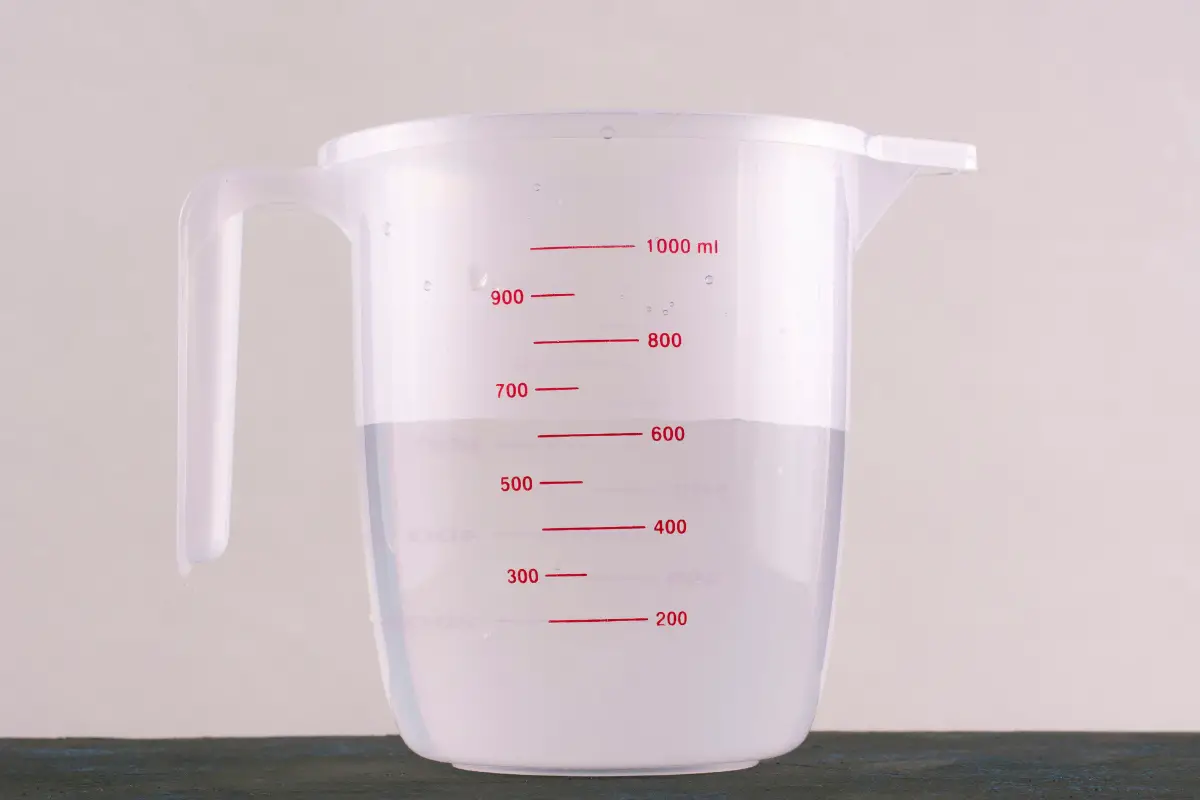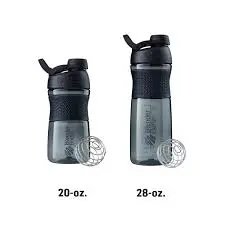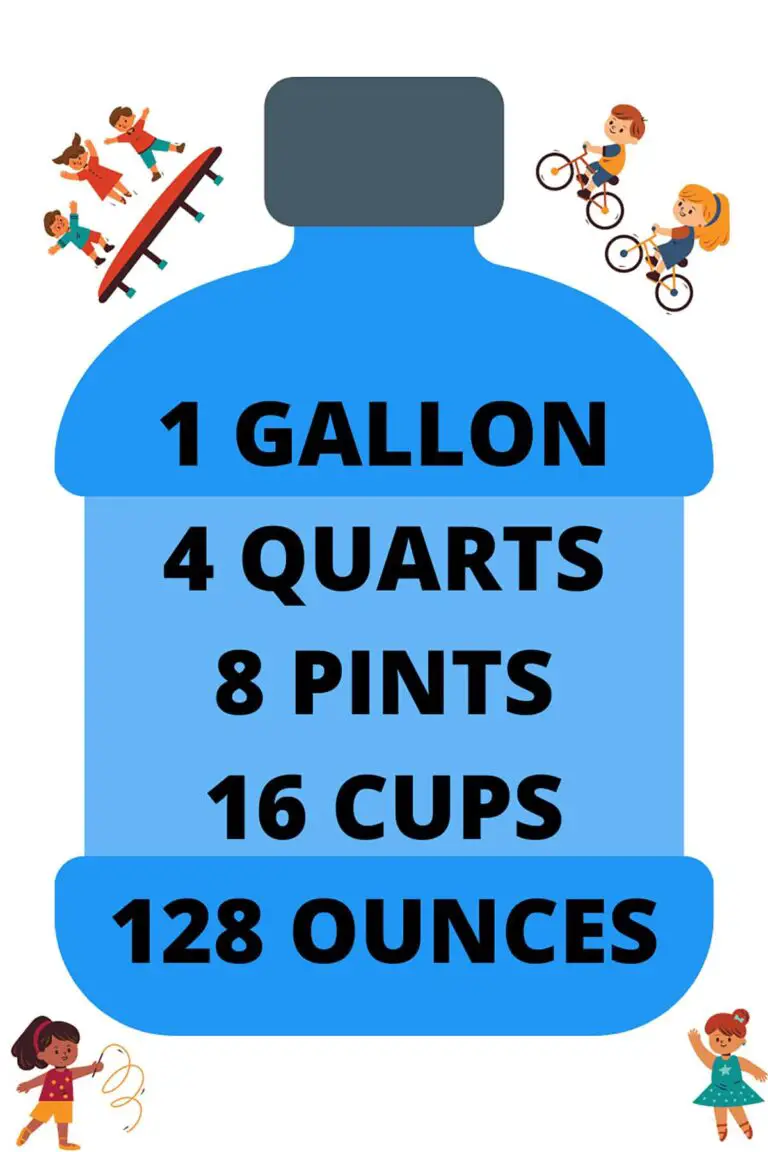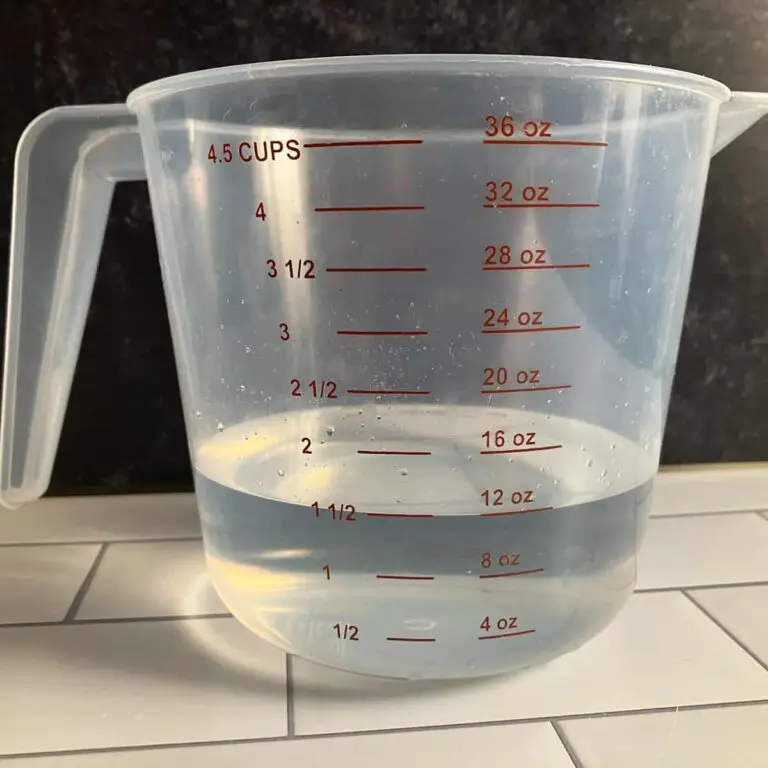Do you find yourself constantly wondering how many cups are in a 16.9 fl oz bottle? The conversion between fluid ounces and cups can be a bit confusing, but don’t worry, we’ve got you covered. In this blog post, we’ll dive into the factual data and provide you with a concise guide on how to convert 16.9 fl oz to cups. So whether you’re trying to measure ingredients for a recipe or figure out how much liquid you’ve consumed, we’ve got all the information you need right here. Stay tuned to learn how to make this conversion effortlessly and accurately.
I. Understanding Fluid Ounces and Cups
The concept of fluid ounces and cups
Whether you’re following a recipe, measuring liquids, or trying to understand serving sizes, understanding fluid ounces and cups is essential. Fluid ounces (fl oz) and cups are common units of measurement used to quantify the volume of liquids.
A fluid ounce is a unit of volume commonly used in the United States and is equivalent to 1/128th of a U.S. gallon. Cups, on the other hand, are a larger unit of measurement and are widely used for both cooking and serving beverages. One cup is equivalent to 8 fluid ounces.
To convert 16.9 fluid ounces to cups, you can use a simple calculation method. Divide the number of fluid ounces by the conversion factor of 8 (since there are 8 fluid ounces in 1 cup). In this case, dividing 16.9 by 8 gives you approximately 2.11 cups.
Here’s a conversion table that provides a quick reference for fluid ounces to cups:
| Fluid Ounces (fl oz) | Cups |
|---|---|
| 1 | 1/8 |
| 4 | 1/2 |
| 8 | 1 |
| 16 | 2 |
| 32 | 4 |
| 128 | 16 |
Knowing the conversion between fluid ounces and cups is particularly useful when dealing with common beverage sizes. For example, a 16.9 fluid ounce bottle of water is approximately 2.11 cups, which is slightly over 2 cups.
Understanding fluid ounce to cup conversions is also beneficial in everyday life. Whether you’re adjusting a recipe, measuring liquid ingredients, or understanding portion sizes, accurately converting fluid ounces to cups ensures you achieve the desired outcome.
In conclusion, having a clear understanding of fluid ounces and cups is essential for various purposes, from cooking and baking to understanding serving sizes. Being familiar with the conversion factors allows for accurate measurements and ensures desired results in any liquid-related task.
Conversion factors between fl oz and cups
When it comes to converting fluid ounces to cups, it’s important to understand the conversion factors between these two units of measurement. The conversion factor from fluid ounces (fl oz) to cups is 1 cup = 8 fl oz. This means that there are 8 fluid ounces in one cup.
To convert 16.9 fl oz to cups, you can divide the number of fluid ounces by the conversion factor. In this case, you would divide 16.9 by 8, which equals approximately 2.11 cups.
Here’s a table that shows the conversion of various amounts of fluid ounces to cups:
| Fluid Ounces (fl oz) | Cups |
|---|---|
| 8 | 1 |
| 16 | 2 |
| 32 | 4 |
| 64 | 8 |
| 128 | 16 |
It’s important to note that fluid ounces and cups are commonly used in recipes and cooking measurements. Understanding the conversion between these units can help you accurately measure ingredients and ensure the success of your recipes. Additionally, being familiar with this conversion is useful when dealing with beverage sizes, such as the popular 16.9 fl oz water bottles, which is approximately 2.11 cups. Having this knowledge allows you to easily compare and understand the volume of different beverages or recipe requirements in cups.
II. What is 16.9 fl oz?
Definition of 16.9 fl oz
The term “16.9 fl oz” refers to a specific measurement of volume. In this case, it represents 16.9 fluid ounces. A fluid ounce is a unit of volume commonly used in the United States and other countries that follow the imperial system of measurement. It is abbreviated as “fl oz” or “oz fl.”
To put it into perspective, 16.9 fluid ounces is equivalent to approximately 0.498 liters or half a liter. This is just shy of two cups, making it slightly less than a typical beverage container size. It’s important to note that fluid ounces are not the same as weight ounces, which measure mass.
The abbreviation “fl oz” is often seen on various products, particularly beverages such as sodas, juices, or bottled water. The 16.9 fluid ounce size is commonly found in single-serving bottles or cans.
Understanding the conversion between fluid ounces and cups is useful in many situations, especially when it comes to cooking, baking, or following a recipe that uses these units of measurement. Being able to accurately convert between the two can help ensure that you use the correct amount of ingredients and achieve the desired outcome in your culinary endeavors.
Common uses for 16.9 fl oz
16.9 fluid ounces (fl oz) is a commonly used measure in various industries and everyday life. Here are some common uses for 16.9 fl oz:
- Bottled Water: Many bottled water products come in 16.9 fl oz bottles, making it a convenient size for on-the-go hydration.
- Soft Drinks: Some carbonated beverages, such as soda or fizzy drinks, are often sold in 16.9 fl oz cans or bottles.
- Energy Drinks: Energy drinks, which are popular among athletes and those seeking an energy boost, are often packaged in 16.9 fl oz cans or bottles.
- Juices and Fruit Drinks: Some juices and fruit drinks, particularly those marketed as single servings, come in 16.9 fl oz containers.
- Sports Drinks: Various sports drinks designed to replenish electrolytes and provide hydration during physical activity are commonly available in 16.9 fl oz bottles.
- Personal Care Products: Many personal care products, such as shampoos, conditioners, body washes, and lotion, come in 16.9 fl oz bottles.
- Cleaning Products: Some cleaning products, including multi-purpose cleaners and laundry detergents, are available in 16.9 fl oz sizes.
Understanding the common uses for 16.9 fl oz can help you accurately measure and consume liquids or use products in the appropriate quantities. It is essential to convert these units accurately to ensure accurate measurements in different contexts.
III. Converting 16.9 fl oz to Cups
Steps to convert 16.9 fl oz to cups
To convert 16.9 fl oz to cups, you can follow these simple steps:
Step 1: Determine the conversion factor between fluid ounces and cups. There are 8 fluid ounces in a cup.
Step 2: Divide the number of fluid ounces (16.9) by the conversion factor (8).
16.9 fl oz ÷ 8 = 2.1125 cups
Step 3: Round the result to the desired number of decimal places if necessary. In this case, let’s round it to two decimal places.
2.1125 cups rounded to two decimal places is 2.11 cups.
So, 16.9 fluid ounces is equal to approximately 2.11 cups.
Here’s a helpful conversion table showing common fluid ounce measurements and their equivalent values in cups:
| Fluid Ounces | Cups |
|---|---|
| 1 fl oz | 0.125 cups |
| 8 fl oz | 1 cup |
| 16.9 fl oz | 2.11 cups |
| 32 fl oz | 4 cups |
| 64 fl oz | 8 cups |
It’s important to understand fluid ounce to cup conversions, especially when dealing with recipes or measuring liquids for cooking or baking. Using accurate measurements ensures that your dishes turn out as intended and helps maintain consistency in your cooking. So the next time you come across a recipe or need to measure liquids, you’ll know exactly how to convert fluid ounces to cups.
Calculation method for conversion
To convert 16.9 fluid ounces to cups, you will need to use a simple calculation method. One cup is equal to 8 fluid ounces, so dividing 16.9 by 8 will give you the equivalent in cups. Let’s break it down:
16.9 fluid ounces ÷ 8 fluid ounces = 2.1125 cups
So, 16.9 fluid ounces is approximately equal to 2.1125 cups.
If you prefer working with fractions, you can also express it as 2 cups and a little over 1/10th of a cup.
Here’s a conversion table that shows common conversions between fluid ounces and cups:
| Cups | Fluid Ounces |
|---|---|
| 1 | 8 |
| 2 | 16 |
| 3 | 24 |
| 4 | 32 |
| 5 | 40 |
| 6 | 48 |
| 7 | 56 |
| 8 | 64 |
It’s important to note that fluid ounces and cups are commonly used measurements in cooking, baking, and recipe instructions. Understanding how to convert between the two can ensure you accurately follow recipes and produce the desired results. Whether you’re preparing a beverage, sauce, or any other recipe, having a good grasp of fluid ounce to cup conversions will help you achieve consistent and delicious outcomes.
IV. Conversion Table
Conversion table for fluid ounces to cups
If you find yourself frequently needing to convert fluid ounces to cups, having a conversion table can be incredibly helpful. Here’s a handy table that shows the conversion factors between fluid ounces and cups:
| Fluid Ounces (fl oz) | Cups (c) |
|---|---|
| 1 | 0.125 |
| 2 | 0.25 |
| 3 | 0.375 |
| 4 | 0.5 |
| 5 | 0.625 |
| 6 | 0.75 |
| 7 | 0.875 |
| 8 | 1 |
| 9 | 1.125 |
| 10 | 1.25 |
| 11 | 1.375 |
| 12 | 1.5 |
| 13 | 1.625 |
| 14 | 1.75 |
| 15 | 1.875 |
| 16 | 2 |
To use this table, simply locate the number of fluid ounces you want to convert and find its corresponding value in cups. For example, if you have 16.9 fluid ounces and want to know how many cups it is, you can see that 16 fluid ounces is equal to 2 cups, so 16.9 fluid ounces would be slightly more than 2 cups.
Having a conversion table like this can save you time and make the process of converting fluid ounces to cups much easier. Whether you’re cooking a recipe that calls for a specific measurement or trying to determine how much liquid is in a container, knowing the accurate conversion can make a big difference in the outcome of your dish or the amount of liquid you consume
Other common conversions for reference
In addition to converting 16.9 fluid ounces to cups, it’s helpful to be familiar with other common conversions for reference. Here are some frequently used conversions to keep in mind:
1 fluid ounce (fl oz) is equivalent to approximately 0.125 cups.
1 cup is equal to 8 fluid ounces.
These conversions can be useful in various situations, whether you’re cooking, baking, or simply trying to understand the volume of a liquid. For example:
- To convert 32 fluid ounces to cups, divide by 8: 32 fl oz ÷ 8 = 4 cups
- To convert 12 fluid ounces to cups, divide by 8: 12 fl oz ÷ 8 = 1.5 cups
- To convert 64 fluid ounces to cups, divide by 8: 64 fl oz ÷ 8 = 8 cups
Having a grasp of these common conversions allows you to accurately measure and follow recipes, ensuring the desired results. It also comes in handy when dealing with different units of measurement in the kitchen, simplifying the cooking or baking process.
Understanding fluid ounce to cup conversions is not only helpful in the culinary world but can also be beneficial in various everyday situations. Whether you’re measuring liquids for hydration, determining serving sizes for beverages, or converting measurements for educational or scientific purposes, having a good grasp of these conversions is essential.
Therefore, being able to convert fluid ounces to cups and vice versa is a valuable skill that can save you time and help you achieve accurate measurements in a wide range of contexts. So, remember to keep these conversions in mind for your everyday needs!
V. Examples of 16.9 fl oz in Cups
Examples of popular beverages in 16.9 fl oz and their cup equivalents
In the world of beverages, 16.9 fluid ounces is a common measurement that corresponds to a specific quantity. Let’s take a look at some popular beverages that come in this size and their cup equivalents:
- Bottled Water: Most single-serve bottled water comes in a 16.9 fl oz size, which is equivalent to approximately 2 cups. This is a convenient size for on-the-go hydration.
- Soft Drinks: Many carbonated soft drinks, such as cola or lemon-lime soda, are also often available in 16.9 fl oz bottles. This amount is equal to around 2 cups or half a pint.
- Sports Drinks: Popular sports drinks, designed to replenish electrolytes after physical activity, often come in 16.9 fl oz bottles. This is equivalent to approximately 2 cups or half a pint.
- Juice Drinks: Some fruit juice blends or juice cocktails also come in 16.9 fl oz containers. This amount is equal to around 2 cups or half a pint. Keep in mind that the sugar content may vary depending on the brand and type of juice drink.
- Iced Tea: Many iced tea brands offer their products in 16.9 fl oz bottles, which is equivalent to roughly 2 cups or half a pint. This size is commonly found in both sweetened and unsweetened varieties.
It’s important to note that these examples are approximate conversions, as the actual volume may vary slightly depending on the specific product or brand. However, understanding the cup equivalent for 16.9 fl oz can help you better visualize and compare the amount of liquid you’re consuming.
Practical applications of the conversion
Understanding the conversion from 16.9 fluid ounces to cups can have practical applications in various contexts. Here are a few examples:
- Cooking and Baking: Many recipe measurements are listed in cups, and knowing how to convert fluid ounces to cups is essential for accurately following recipes. Whether you’re measuring liquids like milk or water, or even converting from a different unit of measurement, being able to convert 16.9 fluid ounces to cups ensures your recipes turn out just right.
- Portion Control: If you’re watching your calorie intake or following a specific diet plan, knowing the cup equivalent of 16.9 fluid ounces can help you control your portion sizes. For example, if you have a beverage that contains 16.9 fluid ounces, understanding that it is equivalent to approximately 2.11 cups can help you monitor your fluid intake more effectively.
- Daily Hydration: Many health experts recommend drinking a certain amount of water per day for optimal hydration. Knowing the cup equivalent of 16.9 fluid ounces can help you track your daily water intake more easily. For instance, if you aim to drink eight cups of water per day, you can calculate how many bottles of 16.9 fluid ounces you need to consume.
By understanding the practical applications of converting 16.9 fluid ounces to cups, you can navigate various scenarios that involve measuring and estimating fluid amounts accurately. This knowledge allows you to follow recipes, control portion sizes, and maintain proper hydration levels more effectively.
X. Summary of the importance of understanding fluid ounce to cup conversions
Understanding fluid ounce to cup conversions is essential in various contexts, especially in cooking and baking. Whether you’re following a recipe or adjusting ingredient measurements, knowing how to convert between these units accurately can greatly impact the outcome of your culinary creations. Here’s a summary of the importance of understanding fluid ounce to cup conversions:
- Precision in recipes: Many recipes provide measurements in cups, while others may use fluid ounces. Being able to convert between the two ensures that you can follow recipes accurately without compromising the taste or texture of the final dish.
- Consistent portion sizes: Understanding fluid ounce to cup conversions allows you to control portion sizes when serving beverages. This is particularly important when hosting parties or preparing drinks for a specific number of guests.
- Avoiding measurement errors: Using the wrong measurement unit can lead to inaccurate ingredient quantities, resulting in dishes that are either too dense or too diluted. Having a clear understanding of fluid ounce to cup conversions helps prevent measurement errors and ensures consistent results.
- Adjusting recipes: Sometimes, you may want to double or halve a recipe. Converting the measurements from fluid ounces to cups makes it easy to scale the recipe up or down, ensuring that the flavors and proportions remain balanced.
Having a basic understanding of fluid ounce to cup conversions not only enhances your cooking and baking skills but also allows you to experiment with different recipes confidently. By paying attention to these conversions, you’ll be well-equipped to create delicious dishes and beverages with precision and consistency.
Final thoughts on using accurate measurements in various contexts
In various contexts, understanding and using accurate measurements, such as the conversion between fluid ounces and cups, is of utmost importance. Whether you’re a cook in the kitchen following a recipe or a bartender mixing beverages, having precise measurements ensures consistency and quality in your final product.
Using the correct measurements can also be crucial in areas such as medication dosage, where accuracy is vital for proper administration and patient safety. Moreover, in the world of science and research, accurate measurements are essential for conducting experiments, analyzing data, and drawing valid conclusions.
To ensure accuracy, it’s important to familiarize yourself with common conversion factors and reference tables. For example, knowing that 1 fluid ounce is equal to approximately 0.125 cups allows you to easily convert measurements from one unit to another.
However, it’s worth noting that some recipes or situations may require even more precise measurements. In these cases, it may be helpful to invest in more specialized measuring tools, such as liquid measuring cups or digital scales, to ensure the utmost accuracy.
In conclusion, understanding and utilizing accurate measurements, including the conversion between 16.9 fluid ounces and cups, is essential in a variety of contexts. Whether it’s for cooking, mixing beverages, or any other application, precise measurements contribute to the quality, consistency, and safety of the final product. So, the next time you embark on a culinary adventure or need to convert fluid ounces to cups, remember the importance of accuracy and use the appropriate tools and conversion methods.




